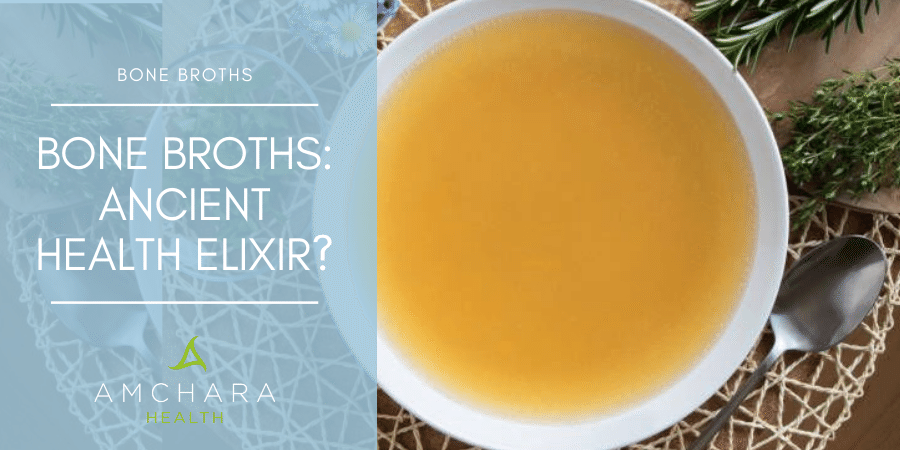Topics Covered in this article:
Bone broths are an ancient and historic remedy that were used to treat the ill and weak – boiling the carcasses of animals ensured that there was no waste from food. Bone broth Is reported to have a vast array of healthful nutrients and in recent years there has been a surge in interest in the use of bone broth for health.
We always take an evidence-based approach to provide you with actionable knowledge and tips to help you on your journey to optimal health, so let’s take a look at bone broth in more depth.
What is bone broth?
The term bone broth can seem off-putting for some people but simmering bones from lamb, beef and carcasses from poultry is a traditional way of making a stock. Many good chefs will tell you that in order to achieve a good depth of flavour a decent bone stock is required.
Fast paced lives, and perhaps a lost knowledge on cooking from scratch, have meant that stock is now purchased commercially – this is not normally produced in the same traditional way using bones.
When making a bone stock, the use of vinegar or lemon juice is reported to aid in drawing out the nutrients. Adding vegetables, or the meat or skin of animals, is suggested by some people and although these are skimmed off at the end of cooking they are said to increase the nutrient value of the broth.
Cooking time is usually long and on a low heat to ensure no nutrients are damaged by heat. The use of slow cookers has meant that bone broth can be easily made at home.
What nutrients are in bone broth?
Bones are a rich source of many nutrients and it is thought that once bones have been simmered for a long time they release these nutrients into the broth. As the ends of bones are also covered in connective tissue in the form of cartilage, the nutrients contained in this are also found within the broth.
These nutrients include:
Collagen and gelatin – 25% of protein in bone is collagen. The structure of bones, skin and cartilage is highly dependant on the collagen content. Gelatin is the term given to collagen extracted from bone and other structures into a broth. In traditional Chinese herbal medicine gelatin, called ejiao, has been used for a variety of health issues including building the blood (1).
Glycine and proline – these two amino acids make up two thirds of collagen.
Glycine is incorporated into many tissues and is vital for the synthesis of heme, the oxygen carrying compound in red blood cells. It is also involved in energy, bile production and fat digestion, detoxification and the formation of a key body antioxidant called glutathione (2). A variety of studies show that glycine is important for stomach acid secretion (3) and for supporting protein synthesis and wound healing, immunity and enhancing antioxidant activity.
Proline is found in most proteins in the body and is incorporated into many connective tissues such as cartilage, tendons, ligaments and bones as well as skin. It is important for maintenance of joint structures, skin health, tissue repair and cardiovascular health (4).
Glycosaminoglycans (GAGs) – cartilage is rich in molecules made up of a core protein with long strands of GAGs. The main GAGs found in cartilage are chondroitin, glucosamine and hyaluronic acid. These help to maintain and support the connective tissues, including the protective gut lining.
Chondroitin and glucosamine are now common additions to joint support due to their known benefits for structural tissues within the joints. Chondroitin has also been shown to have anti-inflammatory properties (5) that may be of use in many inflammatory conditions and studies in mice show that it may reduce the development of atherosclerosis (6).
Hyaluronic acid attracts water and aids in keeping joints lubricated as well as playing a role in wound healing (7).
Minerals – during the cooking process many of the minerals in the broth ingredients are released, including calcium, phosphorus, magnesium, sulphur, sodium and potassium.
Minerals have a variety of functions within the body including:
- Forming structures for connective tissues like bone
- Communication and transmission of information through nerve signalling
- Triggering enzymes used in body functions.
Minerals can influence many aspects of health and function, including bone strength and flexibility, mental health, energy production, muscle function, cardiovascular function and detoxification.
Why is bone broth used?
Due to the vast array of nutrients present in bone broth it may be useful in a variety of situations. For many centuries the use of a broth or chicken soup has been suggested to build up the elderly or infirm.
As the nutrients in bone broth may support issues with supportive structures, gut health and immunity, the following conditions may benefit from bone broth intake:
- Poor wound healing
- Soft tissue injury
- Surgery
- Poor bone health
- Joint issues
- Receding gums
- Skin issues
- Anaemia
- Fatigue
- Detoxification
- Cardiovascular issues
- Poor digestion and absorption
- Low stomach acid
- Reflux
- Leaky gut
- Irritable Bowel Syndrome (IBS)
- Inflammatory Bowel Disease (IBD)
- Food allergies and intolerances
- Inflammation
- Oxidative stress
- Autism spectrum disorder
- Schizophrenia
A word about heavy metals and toxins
Some experts have concerns over the use of bone broth due to the fact that heavy metals such as lead can accumulate in animal bones and during cooking these are thought to be released into the broth. One study showed that lead levels in bone broth were eight to ten times that found in water (8). A more recent study indicated that the risks of lead and cadmium are minimal because the levels were in the ranges of a few μg per serving (9). However, the authors state that the intake of large volumes of homemade bone broth over a long period may pose more of a problem.
Using the bones from organically reared, grass fed animals may reduce the accumulation of toxins, hormones and antibiotics.
In the modern world it has become common to shy away from traditional remedies for supporting health. Science and research have brought in many pharmacological solutions for poor health.
In the past decade or so there has been a shift in research into the benefits of natural compounds and this is now showing that many of the remedies suggested historically have sound physiological benefits. Using bone broth for health can supply many vital nutrients and it may be useful for a wide range of health issues.
If you would like further information on the benefits of bone broth then seeking guidance from an experienced Personalised Health practitioner is advisable.
We’re dedicated to providing you with both insightful information and evidence-based content, all orientated towards the Personalised Health approach.
Did you find this article useful?
We would love to know your thoughts.
With your comments we’d love to continue the conversation.
Let us know if you have used bone broth to support your health.
Read this next:




